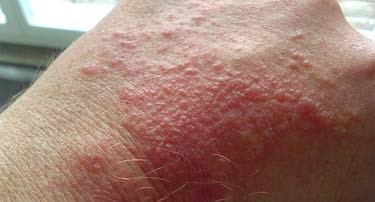Rhus tox

Poison ivy
When planting a garden of medicinal plants for homeopathic healing purpose, a self experiment was undertaken to show the topical poisonous action of Rhus toxicodendron.
A young shoot with several leaves was rubbed vigorously on the skin of the back of the hand.
- 2nd day no noticeable change
- 3rd day the beginning of redness on the back of the hand
- 4th day small blisters begin to appear, the redness intensifies, itching develops, particularly intense during night
- The blisters are very hard and feel strange when touched.
- Redness and blistering on the underarm area that are not affected by intensive sunlight are prone to have a red/violet colour after a three week period with extreme pruritus and peeling of the skin
- 5-6 weeks later all the symptoms have vanished
by Robert Müntz, June 2010

Acute Toxicity
In Humans:. After oral intake of a larger amount (for example an overdose of homeopathic preparations), local reactions can be nausea, vomiting, culminating in blood specked diarrhoea accompanying the beginning of an ongoing gastroenteritis. In more sensitive persons even D4 and D6 dilutions could cause blisters and pustules on the face, and neck or arms.
Resorptive toxications can be dizziness, drowsiness and an agitated state as well as the aforementioned skin reactions.
The digestive organs such as kidneys can be affected by the impact of the Rhus toxicodendron, a hematuria surge can happen after high dosages have been ingested, these can also manifest themselves in diuresis.
Source: Hagers Enzyklopädie der Arzneistoffe und Drogen 2009
Giftsumach, echter, Poison ivy, eastern, Rhus verrucosum, Toxicodendron pubescens, Toxicodendron quercifolium, Wurzelsumach, Rhus toxicodendron is available in our online shop
